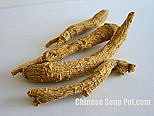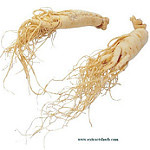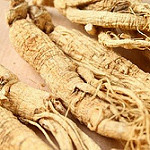Ginseng Root – a Prototype Tonic Herb

Using Ginseng root is a fantastic way to introduce yourself to the benefits of tonic herbs
What is a Tonic Herb?
The word tonic is often used to denote a herb that cleanses or tones up the body on a cellular level. Potent cleansing herbs that belong to this category include dandelion, boneset, horseradish, burdock, nettles, and meadowsweet [1].
However, in a much more rigorous sense, the tonic herbs nourish and supplement the body, providing dense nutrients and direct active energy to the cells and tissues, so they can function better.
One of the most important herbs in this category is Ginseng.
The main function of Ginseng and the other tonic herbs is not related to relieving symptoms of a disease or ailment, but to improving or strengthening the natural processes and systems of the body.
All tonic herbs are also medicinal herbs, however not all medicinal herbs can be used as tonics.
Researchers have often use the term “adaptogen” to portray some of these tonic herbs. They discovered that adaptogenic herbs have a strong effect when the person taking these herbs is under a great deal of stress.
Table of Contents
Ginseng Root
Ginseng root is almost certainly the most familiar of all adaptogens. There are quite a few different types of Ginseng, all of which share same similar characteristics. Check those listed below.
 |
Panax Ginseng is the best known of the Ginsengs. It is most often obtainable as “Red” or “White” Ginseng. (The difference between Red Ginseng and White Ginseng is how the roots are treated after harvesting.)
Some people find that Panax Ginseng is too stimulating for them, and have found Siberian Ginseng (see below) to be a better choice for them. |
 |
American Ginseng ( Panax Quinquefolium) which some time ago grew in its natural habitat in great amounts. However, overharvesting has made natural American Ginseng very scarce.
Botanically, this variety is closely related to the Panax Ginseng. |
 |
Siberian Ginseng (Eleutherococcus Senticosus) often called Eletheuro may be the most investigated herb in the world.
This was the very first herb described as an adaptogen. The herb with latin name Acanthopanax Gracilistylus is also sold under the name Siberian Ginseng, and shares many properties with Eleuthero. |
If you are not sure which one to take, the top spot is certainly reserved for Panax ginseng.
The American relative, Panax quinquefolium, is also quite potent, but not as strong in terms of energy boost as the Chinese variety.
Panax quinquefolium is therefore considered more of a blood tonic.
A single root of wild Panax ginseng can be purchased at the price of a couple of thousands of dollars.
Wild, wood-grown dried American ginseng root is valued from around $500 to $1000 Per LB for a 10 to 40 Years Old. The price depends on the quality and whether the root is fresh or dried.
Most of the commercial ginseng, however, is cultivated [2].
In the Chinese Traditional Medicine, ginseng is being used in cases of Chi deficiency. Today, millions of people are chronically suffering from energy deficiency.
Short term solutions such as coffee and other caffeinated drinks can solve this problem only temporary, and can bring some additional problems.
While some experts suggest too much coffee tires out our adrenal glands, this might not be entirely accurate. However, what’s certain is that too much coffee leads to higher cortisol (stress hormone) and epinephrine response, which in turn brings more stress to our body [3].
Rather than relying on this hormonal response as a source of energy, what we really need is more energy at the cellular level (energy produces in the cellular powerhouse, the mitochondria).
Ginseng activates exactly that kind of energy. A recent study [4] seems to confirm this assumption.
Where does the incredible power of Ginseng come from?
This question would be easy to answer if you knew this: The active components of Ginseng, Ginsenosides, develop, on average, only after 8 years of growth.
Ginsenosides belong to the family of triterpenoid saponins, responsible for the health effects of this plant. These compounds are a result of the accumulated ability of the ginseng root to resist the stressors in its environment.
Because it takes time for the active components to develop, no wonder wild ginseng is expensive.

Health Benefits
Some health benefits and pharmacological effects of Panax Ginseng include:
- increased endurance;
- improved blood circulation;
- help in fighting insomnia;
- anti shock effect;
- lowering blood pressure;
- improved capability of response to stress;
- improved mental function;
- anti-inflammatory action;
- anti-cancer action;
- anti-allergic action;
- improved cholesterol metabolism;
- promotes promote protein, RNA, and DNA synthesis;
- better blood sugar regulation;
- enhanced gonadal function;
- improved blood flow to the brain.
(A full listing would take a lot more space.)
All varieties of Ginseng function as adaptogens, and act as a tonic herb on your body system. Check reference [6] for more on the Chinese tonic herbs and their application. They are generally all safe and suitable for long term use.
That said, many herbalists believe that Siberian Ginseng is the safest of the Ginsengs.
Siberian Ginseng [5] is often used with older or frail individuals, to help improve their energy levels.
All of the Ginseng roots are obtainable as raw herbs, in a form of capsules and powders.
Of course, using them as capsules or powders is the easiest way – simply follow the manufacturer’s instructions on the bottle.
It is probably true that using standardized extracts give you less health benefit than if you’d take the whole root in its natural form.
Trying one or more of the varieties of Ginseng root is a good way to introduce yourself to the benefits of the adaptogens.
How to Prepare Ginseng Root
If you decide to go for the Ginseng root in its natural form, there are several good ways to ingest it. You should consult your doctor for the right dosage though. A rough estimate could be from 1 to 3 grams daily, depending on your constitution and condition.
- Stew. Cut the root into 1 inch pieces, put them into a bowl with water, and stew them for 4-5 hours.
- Chew. Yes, you can eat ginseng raw. Chew a tiny slice of ginseng root very slowly. It is refreshing and tasty.
- Powder. Grind ginseng root into powder and ingest it on a daily basis.
- Tea. Ginseng tea is easy to prepare. Slice the desired quantity of Ginseng root in a bowl, pour some boiling water, and wait for something like 5 minutes.
Ginseng can increase your chronic energy problems relatively quickly, depending on the daily dosage and quality of the ginseng ingested.
It is amazing how your stamina and endurance can change for the better.
People report having great sleep, being refreshed in the morning, having less stress, and more natural libido. The research of the medical application of Ginseng is extensive [7].
Side effects
Tonic herbs are usually very safe to use, with very few or no side effects, and numerous health benefits. Even though considered pretty safe, there are still some side effects worth thinking about, especially if you take too much Ginseng.
As Ginseng promotes the Yang-type energy levels, too much Ginseng may lead to aggression, physical tightness, and increased blood pressure.
So consult your doctor if you have high blood pressure.
A good tip could be taking your daily dosage of Ginseng for a week and then making a pause for a couple of days to see if there are any lasting effects. If there are, you may pause for even longer periods of time.
Just make sure you have a good quality Ginseng (and other Chinese tonic herbs for that matter).
Ginseng can transform your entire life. It can make a difference, probably subtle at first, but its effect is cumulative.
To your health!
References
[2] Higher prices reported for 2014 ginseng crops
[3] http://www.precisionnutrition.com/coffee-and-hormones
[1] Cleansing herbs
[4] Regulation on energy metabolism and protection on mitochondria of Panax ginseng polysaccharide.
[5] Uses, Side Effects, Interaction, and Dossing of Siberian Ginseng
[6] More on Chinese tonic herb and their uses
[7] More on Ginseng Research (check the references therein)
Photo 1 credit: Sharon Lee
Ptoto 2 credit: Candy Fa
Photo 3 credit: Stefan Richards


If anyone wants to find a good place to buy ginseng, check out https://wisconsingrownginseng.com/. I have bought a lot of roots from them. Shipping is always fast and I’ve never had any issues ordering.
Thanks for the tip Morgan. As far as I can see they sell the American variety of ginseng.